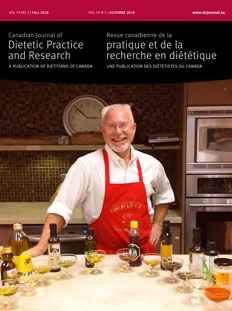Abstract
Purpose: Parents influence the foods their children consume and often provide proxy reports of this intake. One way parents exert this influence is by providing home-packed lunches. This study compared parental reports of foods packed in children’s lunches with what was actually packed and identified parental barriers and facilitators to packing lunches.
Methods: Grade 3 and 4 student–parent dyads (n = 321) in 19 elementary schools in Ontario participated. Parental reports and actual packed lunch contents were collected via self-administered surveys and direct observation, respectively. Parental barriers and facilitators were obtained through open and closed survey questions.
Results: Median portions packed were significantly higher for sugar-sweetened beverages and snacks and significantly lower for fruits, fruit juice, vegetables, milk/alternatives, and meat/alternatives than parents reported. Packing a healthy lunch was “important/very important/of the utmost importance” for 95.9% of respondents, and 97.5% perceived their nutrition knowledge as “adequate/good/very good”. Barriers to packing a lunch included: child’s food preferences, time, finances, allergy policies, and food safety. Nutrition resources, observing other children’s lunches, child’s input, and planning ahead were identified as facilitators.
Conclusions: Strategies to improve packed lunches should move beyond parental nutrition knowledge and importance of lunch packing to address parental barriers and facilitators.
Résumé
Objectif. Les parents ont une influence sur les aliments que consomment leurs enfants et fournissent souvent des déclarations par personne interposée à cet égard. Ils exercent entre autres cette influence en préparant des boîtes à lunch. Cette étude a comparé les aliments déclarés par les parents au contenu réel des boîtes à lunch et a ciblé les obstacles et les facteurs qui facilitent la préparation des boîtes à lunch chez les parents.
Méthodes. Des dyades parent-élève de 3e ou de 4e année (n = 321) de 19 écoles primaires de l’Ontario ont participé à l’étude. Des renseignements sur le contenu des boîtes à lunch, réel et déclaré, ont été recueillis à l’aide d’observations directes et de sondages auto-administrés, respectivement. Enfin, l’information sur les obstacles et les facteurs facilitants a été obtenue au moyen de questions de sondage ouvertes et fermées.
Résultats. La taille médiane des portions servies était considérablement plus élevée pour les boissons et les collations sucrées, et nettement moins élevée pour les fruits, le jus de fruits, les légumes, le lait et ses substituts, et les viandes et leurs substituts, que ce que les parents avaient déclaré. Préparer des dîners santé était « important/très important/extrêmement important » pour 95,9 % des répondants. Par ailleurs, 97,5 % d’entre eux considéraient leurs connaissances en nutrition comme « adéquates/bonnes/très bonnes ». Les obstacles à la préparation des boîtes à lunch comprenaient : les préférences alimentaires de l’enfant, le temps, le budget, les politiques relatives aux allergies et la salubrité des aliments. Les ressources sur la nutrition, l’observation du contenu de la boîte à lunch d’autres enfants, la rétroaction de l’enfant et la planification ont été reconnues comme des facteurs facilitants.
Conclusions. Les stratégies visant à améliorer la préparation des boîtes à lunch devraient tenir compte des connaissances parentales en nutrition et de l’importance des dîners santé, mais également des obstacles et des facteurs facilitants vécus par les parents.



